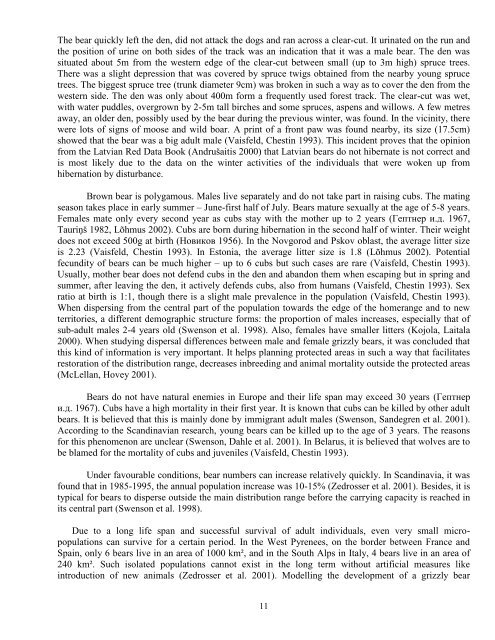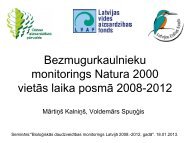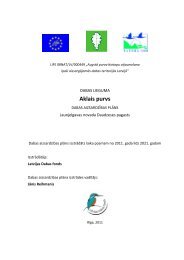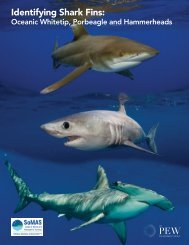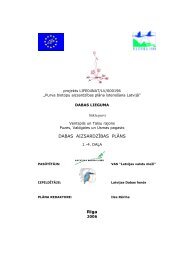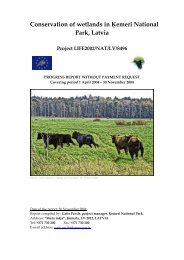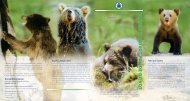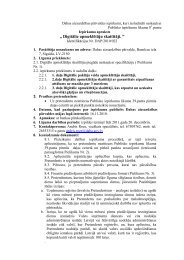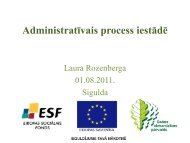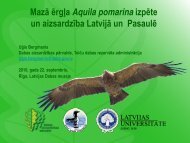Brown bear Ursus arctos - Dabas aizsardzības pārvalde
Brown bear Ursus arctos - Dabas aizsardzības pārvalde
Brown bear Ursus arctos - Dabas aizsardzības pārvalde
Create successful ePaper yourself
Turn your PDF publications into a flip-book with our unique Google optimized e-Paper software.
The <strong>bear</strong> quickly left the den, did not attack the dogs and ran across a clear-cut. It urinated on the run and<br />
the position of urine on both sides of the track was an indication that it was a male <strong>bear</strong>. The den was<br />
situated about 5m from the western edge of the clear-cut between small (up to 3m high) spruce trees.<br />
There was a slight depression that was covered by spruce twigs obtained from the nearby young spruce<br />
trees. The biggest spruce tree (trunk diameter 9cm) was broken in such a way as to cover the den from the<br />
western side. The den was only about 400m form a frequently used forest track. The clear-cut was wet,<br />
with water puddles, overgrown by 2-5m tall birches and some spruces, aspens and willows. A few metres<br />
away, an older den, possibly used by the <strong>bear</strong> during the previous winter, was found. In the vicinity, there<br />
were lots of signs of moose and wild boar. A print of a front paw was found nearby, its size (17.5cm)<br />
showed that the <strong>bear</strong> was a big adult male (Vaisfeld, Chestin 1993). This incident proves that the opinion<br />
from the Latvian Red Data Book (Andrušaitis 2000) that Latvian <strong>bear</strong>s do not hibernate is not correct and<br />
is most likely due to the data on the winter activities of the individuals that were woken up from<br />
hibernation by disturbance.<br />
<strong>Brown</strong> <strong>bear</strong> is polygamous. Males live separately and do not take part in raising cubs. The mating<br />
season takes place in early summer – June-first half of July. Bears mature sexually at the age of 5-8 years.<br />
Females mate only every second year as cubs stay with the mother up to 2 years (Гептнер и.д. 1967,<br />
Tauriņš 1982, Lõhmus 2002). Cubs are born during hibernation in the second half of winter. Their weight<br />
does not exceed 500g at birth (Новиков 1956). In the Novgorod and Pskov oblast, the average litter size<br />
is 2.23 (Vaisfeld, Chestin 1993). In Estonia, the average litter size is 1.8 (Lõhmus 2002). Potential<br />
fecundity of <strong>bear</strong>s can be much higher – up to 6 cubs but such cases are rare (Vaisfeld, Chestin 1993).<br />
Usually, mother <strong>bear</strong> does not defend cubs in the den and abandon them when escaping but in spring and<br />
summer, after leaving the den, it actively defends cubs, also from humans (Vaisfeld, Chestin 1993). Sex<br />
ratio at birth is 1:1, though there is a slight male prevalence in the population (Vaisfeld, Chestin 1993).<br />
When dispersing from the central part of the population towards the edge of the homerange and to new<br />
territories, a different demographic structure forms: the proportion of males increases, especially that of<br />
sub-adult males 2-4 years old (Swenson et al. 1998). Also, females have smaller litters (Kojola, Laitala<br />
2000). When studying dispersal differences between male and female grizzly <strong>bear</strong>s, it was concluded that<br />
this kind of information is very important. It helps planning protected areas in such a way that facilitates<br />
restoration of the distribution range, decreases inbreeding and animal mortality outside the protected areas<br />
(McLellan, Hovey 2001).<br />
Bears do not have natural enemies in Europe and their life span may exceed 30 years (Гептнер<br />
и.д. 1967). Cubs have a high mortality in their first year. It is known that cubs can be killed by other adult<br />
<strong>bear</strong>s. It is believed that this is mainly done by immigrant adult males (Swenson, Sandegren et al. 2001).<br />
According to the Scandinavian research, young <strong>bear</strong>s can be killed up to the age of 3 years. The reasons<br />
for this phenomenon are unclear (Swenson, Dahle et al. 2001). In Belarus, it is believed that wolves are to<br />
be blamed for the mortality of cubs and juveniles (Vaisfeld, Chestin 1993).<br />
Under favourable conditions, <strong>bear</strong> numbers can increase relatively quickly. In Scandinavia, it was<br />
found that in 1985-1995, the annual population increase was 10-15% (Zedrosser et al. 2001). Besides, it is<br />
typical for <strong>bear</strong>s to disperse outside the main distribution range before the carrying capacity is reached in<br />
its central part (Swenson et al. 1998).<br />
Due to a long life span and successful survival of adult individuals, even very small micropopulations<br />
can survive for a certain period. In the West Pyrenees, on the border between France and<br />
Spain, only 6 <strong>bear</strong>s live in an area of 1000 km², and in the South Alps in Italy, 4 <strong>bear</strong>s live in an area of<br />
240 km². Such isolated populations cannot exist in the long term without artificial measures like<br />
introduction of new animals (Zedrosser et al. 2001). Modelling the development of a grizzly <strong>bear</strong><br />
11


